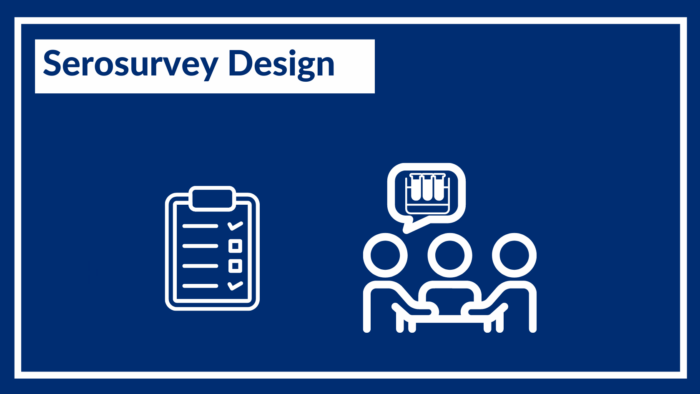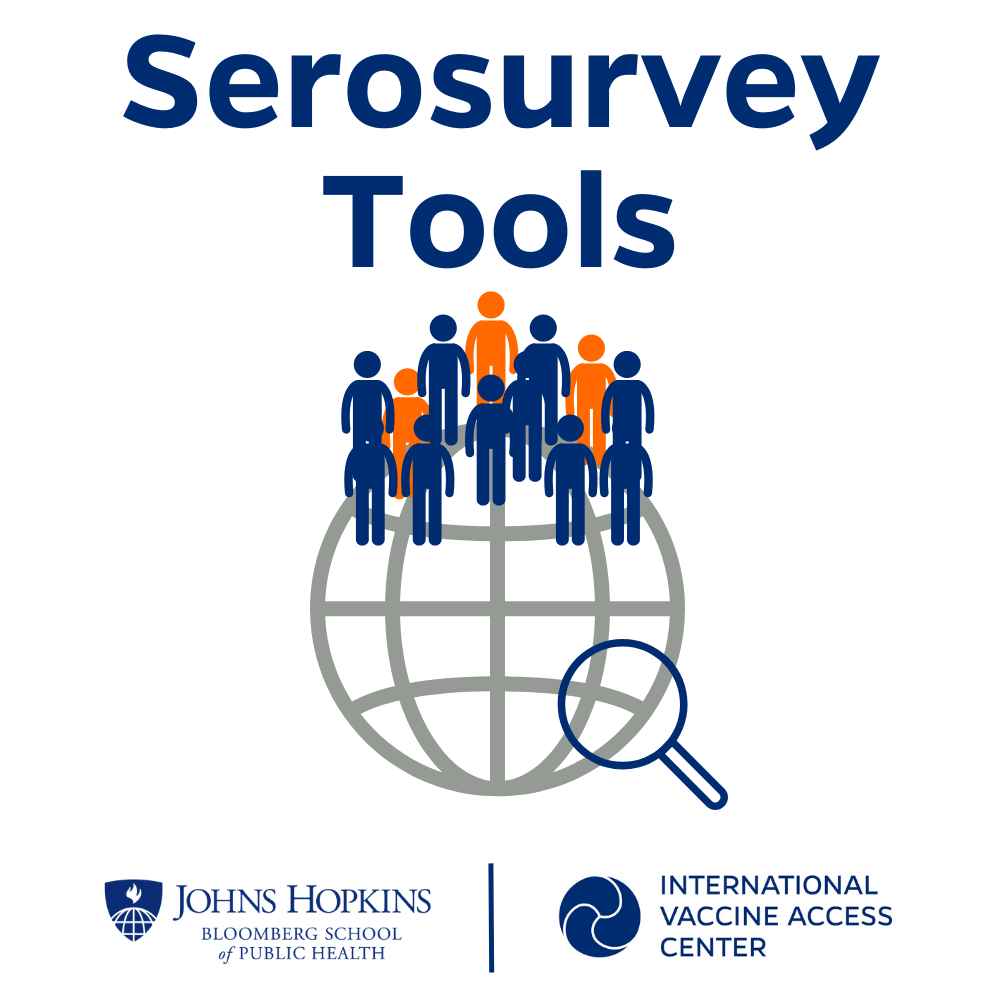- Home
- Serosurvey design

Introduction
There are many issues to be considered when designing a serosurvey. Many of these steps are common to the design of any type of survey, including:
- Defining the survey objectives
- Identifying the target population
- Determining the survey design
- Choosing the specimen type
Refer to the WHO Serosurvey Guidelines and WHO vaccination coverage survey manual for details on study design issues.
Learning Objectives
- Understand potential sources of data and specimens
- Understand considerations in choosing a specimen type
Topics covered in this module
- Characterization of different sources of data and specimens
- Pros and cons of different specimen types used in serosurveys
Contents
- Serosurvey Objectives
- Target Population
- Serosurvey Study Designs
- Choosing a Specimen Type
- Toolkit
- Reference
Serosurvey Objectives
The serosurvey objectives should be developed in consultation with the immunization program and local stakeholders. Consider the following questions in developing the objectives:
- What is the target population of interest?
- Are there specific subgroups (e.g., age groups, communities) of interest?
- What are the vaccine antigens and infectious diseases (e.g., measles, rubella, tetanus) of interest?
- What question(s) are you trying to answer?
- Estimate seroprevalence in specific age groups or geographical areas
- Classify a population based on seroprevalence (e.g., “high”, “intermediate”, low”)
- Compare seroprevalence between subgroups (e.g., HIV infected and uninfected)
- Assess trends in seroprevalence over time
While there may be multiple objectives of interest, the study design and sampling will be guided by the primary objective. Refer to Section 2.3 of the WHO Vaccination Coverage Cluster Survey manual and Section 2.2 of the WHO Serosurvey Manual for more detailed information about survey objectives.
Target Population
There are two main considerations when defining the target population:
- What are the demographic groups of interest (e.g., age cohorts, gender, urban vs. rural setting)?
- Ensure the selected demographic groups will allow you to answer your question of interest. For example, serosurveys evaluating the impact of mass vaccination campaigns or supplementary immunization activities (SIAs) should include children in the age range eligible for the campaign. Serosurveys to inform which ages to target in future campaigns may require a wider age range to identify immunity gaps in older ages.
- What is the geographic or administrative level at which your results should be representative (e.g., national versus subnational vs local level)?
- This will influence the sampling methodology, sample size, logistics and complexity of the survey.
Refer to Section 2.4 of the WHO Vaccination Coverage Cluster Survey manual and Section 2.3 of the WHO Serosurvey Manual for more detailed information about target populations.
Serosurvey Study Designs
There are four main types of study designs used for serosurveys.
- Designs that use existing specimens collected for other purposes:
- Residual blood available in a biorepository from other surveys, studies, or surveillance systems
- Residual blood collected for a clinical purpose at a health facility or laboratory
- Designs that collect new specimens from survey participants:
- Serosurveys nested within a survey conducted for another purpose (e.g., Demographic Health Survey or Multiple Indicator Cluster Survey)
- Stand-alone serosurveys
|
Existing blood specimens |
New specimen collection |
|||
|
Biorepository |
Health facility or laboratory |
Nested serosurvey |
Stand-alone serosurvey |
|
|
Interaction with human participants |
No |
Yes |
||
|
Community-based work |
No |
Yes |
||
|
Time |
||||
|
Design and planning |
Moderate: Develop sampling frame and obtain specimens. |
Moderate: Identify facilities and systems to collect specimens and linked data. |
Moderate: Restricted to specimen-collection aspects. |
High: All aspects of design and planning required. |
|
Data and specimen collection |
None |
Low |
Moderatea |
Higha |
|
Costb |
Low cost: Specimens collected from participants for other purposes. |
Moderate: Added costs for specimen collection. |
High: All general survey and specimen-related costs. |
|
|
Control over Study Design |
Little control: Little to no control over procedure, data availability, and survey quality. Missing data or specimens could result in bias. |
Moderate: Less control over the survey design than stand-alone survey which may result in compromises on procedure, data availability, and survey quality. |
High: Allows for better control of design, sampling, data, and representativeness of the population of interest |
|
|
Other Considerations |
Select existing specimen sources that are representative of the target population, if possible. Ensure ethical approval allows for further testing of specimens. Consider if seroprevalence may have changed since the specimens were collected. |
Additional time, cost, and capacity required to collect specimens (e.g., resources, personnel, community engagement). Results may not be available in a timely manner. |
||
Table 1. Comparing study designs for serosurveys
a. Refer to Specimen Collection module for more details
b. For cost, only the primary drivers are listed
Choosing a Specimen Type
- Different specimen types can be used for serosurveys depending on the antigen of interest. The most common include serum collected from venous blood and dried blood spots (DBS) collected from capillary blood on filter paper.
- Oral fluid can also be used but may have lower sensitivity than blood.
- For community-based serosurveys, specimens may either be collected at a centralized blood collection location or within households.
- Selection of specimen type should consider several factors including but not limited to:
- Objectives of the serosurvey
- Not all laboratory assays can be performed with DBS or oral fluid. Refer to module, Assay Protocols.
- Field conditions for collection of specimens such as:
- Logistical issues including distance from the laboratory, ability to centrifuge specimens at the site of collection and maintain a cold chain during transport, and where specimen collection will occur (centralized location or household).
- Training and expertise of staff collecting specimens.
- Community acceptability of blood collection via venipuncture or fingerprick.
- Laboratory capacity to test and store specimens at appropriate temperatures. Refer to module, Specimen Collection.
- Objectives of the serosurvey
|
Characteristic |
Specimen
Type |
||
|
Liquid
blood |
Dried
blood |
||
|
Whole
blood |
Capillary
blood |
Blood
dried onto filter paper |
|
|
Collection |
Venous Need skilled personnel (i.e., phlebotomist). Requires additional supplies and equipment. Risk of hemolysis during collection. |
Fingerprick |
Fingerprick Consider collecting liquid blood from a subset to calibrate results for DBS using serum. |
|
Transport, Processing, Storage |
Requires cold chain. Requires processing to separate serum from blood within 1-2 days of collection. Risk of hemolysis during transport. |
No cold-chain requirement. Time-to-processing is less critical. |
|
|
Testing |
Repeated thawing of specimen may result in degradation of antibodies. |
Additional elution step required prior to testing. Not all laboratory assays are validated for use with DBS. May obtain lower antibody levels than with serum, impacting sensitivity. |
|
Table 2. Considerations for using serum and DBS for serosurveys. Refer to modules, Specimen Collection and Assay Protocols, for more information.
Toolkit
| Topic | Document | Context |
| Serosurvey Design | Serosurvey Design Worksheets and Flowchart | Generic |
Reference
World Health Organization Vaccination Coverage Cluster Surveys Reference Manual
World Health Organization Guidelines on the Use of Serosurveys in Support of Measles and Rubella Elimination
